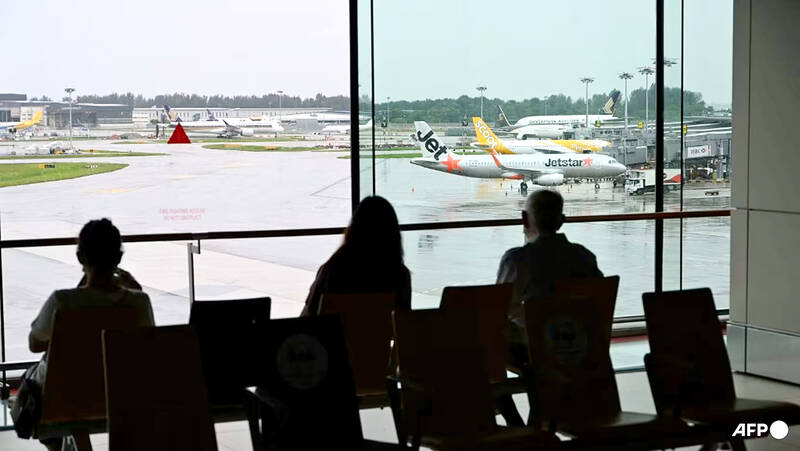Five Southeast Asian nations yesterday said that they had agreed to share aviation data and information among themselves, including reports of severe turbulence, to help make air travel safer.
Indonesia, Malaysia, the Philippines, Singapore and Thailand on Wednesday signed a memorandum of understanding, aiming to launch the plan by the end of the year, their civil aviation authorities said in a joint statement.
The agreement comes as air travel recovers from the COVID-19 pandemic, which hammered tourism in the region.

Photo: AFP
The initiative was mooted last year, but it took time for the countries to agree on what to share and the draw up protocols that would govern data confidentiality.
“In a first-of-its kind initiative in the Asia-Pacific, the five states will collaborate and share de-identified safety data and safety information to identify safety hazards and trends, and develop mitigating measures to better manage safety risks,” the statement said.
The countries identified an initial seven categories to be shared, including collision warnings, deviations from altitudes assigned by air traffic controllers and activation of warning systems on the ground.
Reports of severe air turbulence, wind shear, bird strikes and the carriage of dangerous goods are also to be shared.
The Civil Aviation Authority of Thailand would act as the “custodian” of the data and its Singapore counterpart the “data analyst,” the statement said.
The data, findings and recommendations from analyses of the information “shall not be used to support investigations of accidents and incidents, and shall not be used for punitive or enforcement purposes,” the statement said.
Civil Aviation Authority of Singapore Director-General Han Kok Juan said that he hoped other countries would join “to ensure safer skies for the traveling public.”

LONG FLIGHT: The jets would be flown by US pilots, with Taiwanese copilots in the two-seat F-16D variant to help familiarize them with the aircraft, the source said The US is expected to fly 10 Lockheed Martin F-16C/D Block 70/72 jets to Taiwan over the coming months to fulfill a long-awaited order of 66 aircraft, a defense official said yesterday. Word that the first batch of the jets would be delivered soon was welcome news to Taiwan, which has become concerned about delays in the delivery of US arms amid rising military tensions with China. Speaking on condition of anonymity, the official said the initial tranche of the nation’s F-16s are rolling off assembly lines in the US and would be flown under their own power to Taiwan by way

OBJECTS AT SEA: Satellites with synthetic-aperture radar could aid in the detection of small Chinese boats attempting to illegally enter Taiwan, the space agency head said Taiwan aims to send the nation’s first low Earth orbit (LEO) satellite into space in 2027, while the first Formosat-8 and Formosat-9 spacecraft are to be launched in October and 2028 respectively, the National Science and Technology Council said yesterday. The council laid out its space development plan in a report reviewed by members of the legislature’s Education and Culture Committee. Six LEO satellites would be produced in the initial phase, with the first one, the B5G-1A, scheduled to be launched in 2027, the council said in the report. Regarding the second satellite, the B5G-1B, the government plans to work with private contractors

‘NARWHAL’: The indigenous submarine completed its harbor acceptance test recently and is now under heavy guard as it undergoes tests in open waters, a source said The Hai Kun (海鯤), the nation’s first indigenous defense submarine, yesterday began sea trials, sailing out of the Port of Kaohsiung, a military source said. Also known as the “Narwhal,” the vessel departed from CSBC Corp, Taiwan’s (台灣國際造船) shipyard at about 8am, where it had been docked. More than 10 technicians and military personnel were on deck, with several others standing atop the sail. After recently completing its harbor acceptance test, the vessel has started a series of sea-based trials, including tests of its propulsion and navigational systems, while partially surfaced, the source said. The Hai Kun underwent tests in the port from

MISSION: The Indo-Pacific region is ‘the priority theater,’ where the task of deterrence extends across the entire region, including Taiwan, the US Pacific Fleet commander said The US Navy’s “mission of deterrence” in the Indo-Pacific theater applies to Taiwan, Pacific Fleet Commander Admiral Stephen Koehler told the South China Sea Conference on Tuesday. The conference, organized by the Center for Strategic and International Studies (CSIS), is an international platform for senior officials and experts from countries with security interests in the region. “The Pacific Fleet’s mission is to deter aggression across the Western Pacific, together with our allies and partners, and to prevail in combat if necessary, Koehler said in the event’s keynote speech. “That mission of deterrence applies regionwide — including the South China Sea and Taiwan,” he